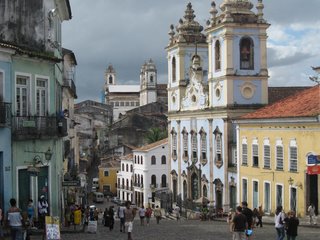
Once the plaza where slaves were hung or tortured, the historic area known as the Pelourinho is Salvador's most touristy. The idea is gnawing. Gentrification has spruced up the colonial facades, traveling bands of vendors offer their trinketry, plump women in white turbans and fluffed skirts wait bored to pose for pictures.
It's my first visit to Brazil, and trying to separate the what it is from its packaging takes work.
I was in the city museum looking at the candomblé figures. A Brazillian approached with explanations. His name was Durval. He didn't work there, but spoke English and Spanish and could be hired for tours and guided visits to the ceremonies. I asked him if he would take me to one. A candomblé ceremony is not a tourist event. I couldn't bring a camera, I couldn't wear dark clothing. It was like being a child again: shut up and sit tight! It was someone else's show. Durval thought it was gutsy of me to go. No, I told him. I've almost no choice. It's curiosity.
The ceremony was in Dike Torroró, a marginal neighborhood. It would be too dangerous to return long after dark on foot, but it was still daylight so we walked, coming off the hill, skirting Brazil's second-largest soccer stadium (a rank urinary) and shards of broken glass. The candomblé houses are marked by flagpoles strung with white flags.
Durval gives me Candomblé 101 on the walk out. A form of ancestor worship, the religion recognizes spirits which watch over us. Those with special powers can invoke the spirit to posess them. In these ceremonies it's as if the individual goes to sleep. They will remember nothing. But the spirit who has visited drinks and sings and counsels.
This ceremony was called Caboclos, celebrating an indigenous divinity. The host had prepared all year for the event, a feat which required heaps of offerings (such as goats and Johnny Walker Red--these didn't come cheap).
An iron gate insulated the small cement house from the street. We were admitted and offered cold beers in flimsy plastic cups. Young men were strewed about the front porch conversing, kids ran rampant. It could have been a birthday or a baptism.
The ceremony in fact was in pause (it had started at noon, now it was five pm, but it could last a couple days). I leaned against a wall and took it in. The inner room was empty, save for a set of bongos. Everyone was in the inner courtyard, a crumbly square stuffed to the gills with people: grandmothers seated, Bahianas in lace dresses serving seafood broth, young women with the curves popping out of their tight tops, young men dressed in loose white cottons shaking and singing sambas. Little kids practice capoeira moves and cartwheels on the bare cement floors indoors.
What strikes me is my own invisibility. I am the only foreigner here, an outsider by miles, yet my intrusion invites no curiosity. Candomblé ceremonies are open to the public. I have been attended to, but not incorporated. The intimacy of the ceremony, its singularity of purpose, remains intact. In my travels the experience is unique. What's theirs is theirs, without explanation. I find it fantastic.
An enormous fleshy man in a tunic smokes a porro and wanders the crowd with a regal air. He wears a leather cap, necklaces and armbands, carries a wooden club decorated with weights and tassles, held cocked over one shoulder. In his gaze there is a clarity and precision that's impossible to mistake. He is the orixa, the spirit. He approaches a group. He tells one of the men about his troubles. The man smiles and nods.
Later, in between samba, shuffling dancers and whiskey poured down the orixa's throat, believers will line up to get the orixa's advice. His eyes are glassy and his words mesh into the drumbeats. The whole pulsing scene shatters a westerner's idea of what religion should be. There is rhythm and movement, alcohol, other worlds floating in and out of view. There are offerings--an altar of flowers and candles, fruits and whole roast goats, chicken feathers and dozens of bottles of cachaca and whiskey. Young men are everywhere, like at a keg party, nothing like today's dying Catholicism. Durval says that if you asked anyone about their religion they will say Catholic, but this is just something else they do. It's impossible to know how many practitioners candomblé has, but there's 2000 registered candomblé houses in Salvador. I think back to my own Sunday school lessons that molded me to divide the sacred and profane, to suspect false idols. I can't speak to the truth but there is no doubt this searching is a tangible experience, external and not internal, and wholly felt. Back in the courtyard the orixa wields his baton in swift movements. A woman stands before him awaiting advice. His voice booms over the crowd. "Life without obstacles is not a life," he repeats. All attentions swerve to follow the rest of the discourse.
No comments:
Post a Comment